Digital Asset Treasuries (DATs) have emerged as a new corporate structure in the equity markets. They are publicly traded entities that raise capital with the explicit mandate to invest, hold, and, in some cases, actively manage their reserve assets. Traditional companies might accumulate Bitcoin or other crypto holdings as a complementary strategy to their primary operations, whereas DATs are purpose-built with the digital asset itself as the core of their business model.
The idea began with Strategy (MSTR, formerly known as MicroStrategy), which pioneered BTC balance sheet accumulation based on the thesis that Bitcoin provides a hedge against monetary debasement. Michael Saylor, the Founder and Executive Chairman's interest in Bitcoin came as a result of watching the Federal Reserve increase the US Dollar money supply. Today it is up ~43% since March 2020.
Strategy began with a simple approach: It would raise equity capital and buy bitcoin. Over time, however, its capital structure became more complex, introducing convertible debt, preferred equity, and other capital market innovations designed to help it raise capital cheaply to deploy into bitcoin. Other DATs have taken this strategy and deployed it to other assets.
DATs have had a transformative impact on bitcoin, with DAT purchases being a primary factor in bitcoin's strong performance versus other assets in the 2024 to early 2025 period. The emergence of ETH DATs also had the same effect, so we thought it was worth uncovering.
Here are some key stats as of 22/09/2025 per Dr Schellinger at Crypto Treasury Tracker:
- Market dominance: BTC (88.6%), ETH (9.4%), SOL (1.5%)
- Weekly inflows: BTC (+2,487), ETH (+91,660), SOL (+7.96M)
- Share of circulating supply: BTC (9.16%), ETH (4.34%), SOL (2.72%)
This Espresso focuses on the growth of Ethereum DATs, which are gaining traction, driving demand for ETH and reshaping supply dynamics. Can DATs do for ETH what they did for BTC? Could they be even more successful? This piece looks into the trend.
Demand outweighs Supply
A Structural Bid Continues
ETH DATs are absorbing more ETH than net new supply (issuance - burn) adds to circulation. For example, purchases in August equated to ~1.97M ETH, which dwarfed net new issuance of ~0.08M ETH, creating persistent demand pressure. This creates what we call a structural bid, where demand from DATs consistently exceeds supply dynamics. Over time, this dynamic reinforces ETH's scarcity and strengthens its position as a treasury asset.
ETH Purchases vs Net New Supply
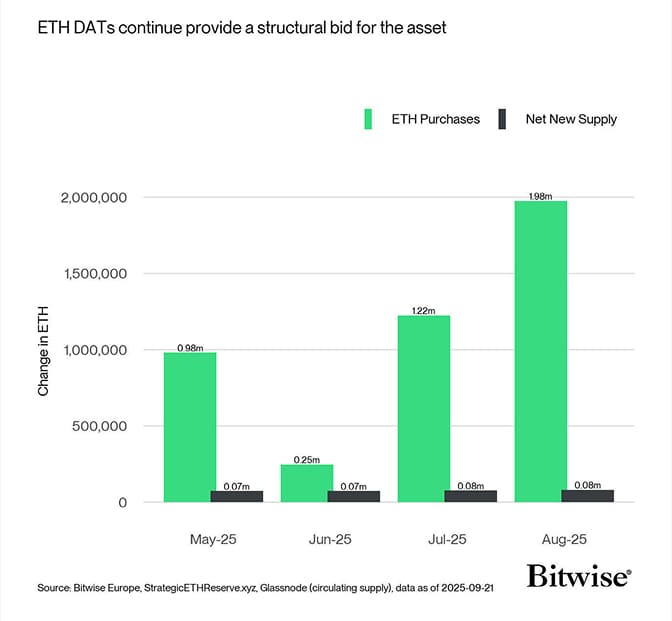 Source: Bitwise Europe, StrategicETHReserve.xyz, Glassnode (circulating supply), data as of 2025-09-21
Source: Bitwise Europe, StrategicETHReserve.xyz, Glassnode (circulating supply), data as of 2025-09-21
ETH as a Yield-Bearing Treasury Asset
Proof of Stake assets redefine reserve return profiles
Bitcoin's capped supply and halving make it nearly impossible for treasury companies to
organically accrete more coins. This scarcity should force these DATs to raise capital at less favorable terms, therefore potentially diluting shareholders and reducing mNAV ratio (market capitalization / net asset value of reserve holding) to 1x over time. Unlike BTC, ETH's uncapped supply and network yield and DeFi strategies create a fundamentally different treasury asset and DAT return profile.
ETH DATs look more like operating businesses than BTC DATs, which simply buy and hold the asset. The income from staking and DeFi strategies enhances mNAV ratio because investors are pricing in future asset growth per share, without the necessary need for share dilution at opportune times. This feature is not possible with BTC DATs.
Hence, the ability to gain yield from staking or on-chain activity, beyond the underlying ETH balance, has proved to be attractive so far. Total ETH reserves held by DATs have surged to ~4.99M ETH, over 4.13% of circulating supply.
Ethereum's yield comes from three main sources:
- staking rewards
- transaction fees
- MEV (extra value from how transactions are ordered).
Staking rewards are earned for helping secure the network, while transaction fees include both base fees and extra payments from users who want their transactions processed faster. MEV represents additional revenue that validators can capture by arranging transactions in certain ways.
Cumulative ETH Strategic Reserves
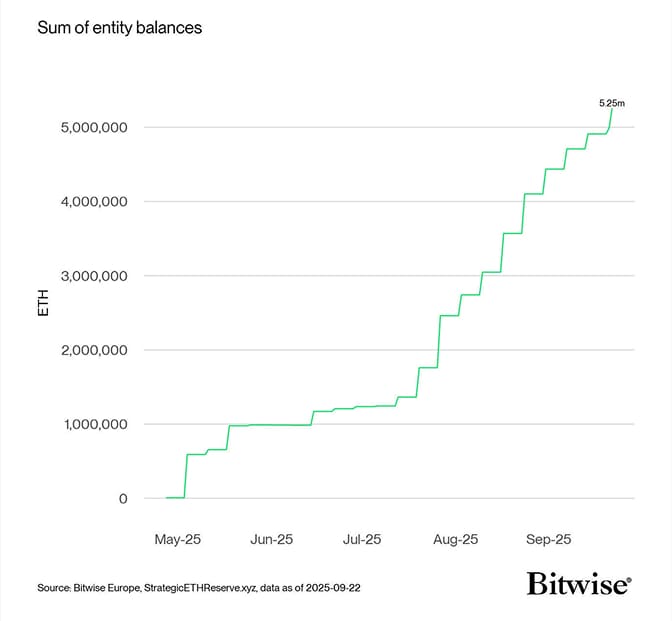 Source: Bitwise Europe, StrategicETHReserve.xyz, data as of 2025-09-22
Source: Bitwise Europe, StrategicETHReserve.xyz, data as of 2025-09-22
Growing Corporate Adoption
Increased Breadth and Depth of Holders
At the time of writing this report, the number of companies holding ETH reserves over 10 ETH (~$41.9k, as of writing) has steadily climbed to 68. This attests to breadth and depth of adoption for ETH as a treasury reserve asset. So far, the main dynamics are likely hype-related from the relative outperformance of ETH over the past six months. However, we still think this is likely to increase for a few reasons.
First, DATs are likely to become some of the largest “users” of the ecosystem. Maximizing the income generated from staking and other on-chain activity also maximizes the mNAV attributed to their equity, since yields will be higher relative to peers.
Staking not only produces revenue-it also provides DATs with influence over the protocol itself. This effect is most pronounced in on-chain governance systems such as Solana, but even in Ethereum, the largest DATs are likely to exert social pressure in off-chain governance debates.
Second, DATs serve as spokespersons to investors: Michael Saylor for Bitcoin and Tom Lee for Ethereum have both done tremendous jobs on shouldering career risk for investors and advancing the credibility of these assets on Wall Street and for institutions.
Finally, although more of a niche opportunity, DATs provide a new point of access for investors who might otherwise struggle to gain ecosystem exposure labs, foundations, or applications. By necessity, DATs must become large players and actively engage with these participants, making them a potential proxy for broader ecosystem involvement.
Weekly Number of Companies with ETH Reserves
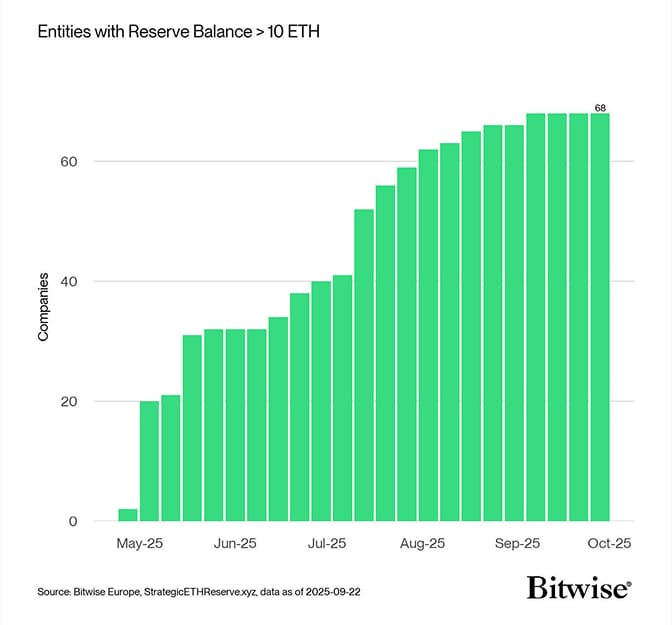 Source: Bitwise Europe, StrategicETHReserve.xyz, data as of 2025-09-22
Source: Bitwise Europe, StrategicETHReserve.xyz, data as of 2025-09-22
The Top ETH Treasuries
Diverse Strategies, One Asset
The top five ETH treasuries illustrate the diversity of strategies emerging among corporate holders. While the scale of reserves varies widely, each has distinct objectives and roles to play in the ecosystem:
- Bitmine Immersion Tech (BMNR, 2.42M ETH, ~2% of supply) allocates ~1% of its balance into investments that support the Ethereum ecosystem and create value for equity shareholders. For example, its $20M strategic investment into Eightco Holdings Inc. which is adopting a first-of-its-kind strategy to acquire Worldcoin (WLD) as its primary treasury asset. This marked the start of BMNR's approach to back bold ideas that strengthen Ethereum's vast ecosystem.
- SharpLink Gaming (SBET, 0.84M ETH) remains fully committed to its gaming and interactive betting business but noted their ETH treasury strategy is complementary to their core operations. SharpLink stakes 100% of balance.
- The Ether Machine (ETHM, 0.50M ETH) will operate as a dedicated Ethereum-native treasury through staking, restaking, and active participation in the broader ecosystem. It also provides validator infrastructure for enterprises and backs open-source research and tooling.
- Ethereum Foundation (0.25M ETH) is a non-profit organization based in Zug, Switzerland (“Crypto Valley”), whose mission is to support Ethereum protocol's growth while maintaining decentralization. The Foundation funds research, developer resources, and community collaboration, anchoring Ethereum's long-term sustainability.
- PulseChain Sac (PLS, 0.17M ETH) is an alternative Layer 1, which leverages its ETH reserves to bootstrap development of the PulseChain ecosystem, with emphasis on cross-chain activity and building complementary infrastructure.
- Other (1.12M ETH collectively) consists of the rest of the entities that own over 10 ETH. This long tail shows breadth, but not necessarily staying power. Many of these will face the “falling star” trajectory where enthusiasm fades and valuations compress.
Top 5 ETH Treasuries + The Rest
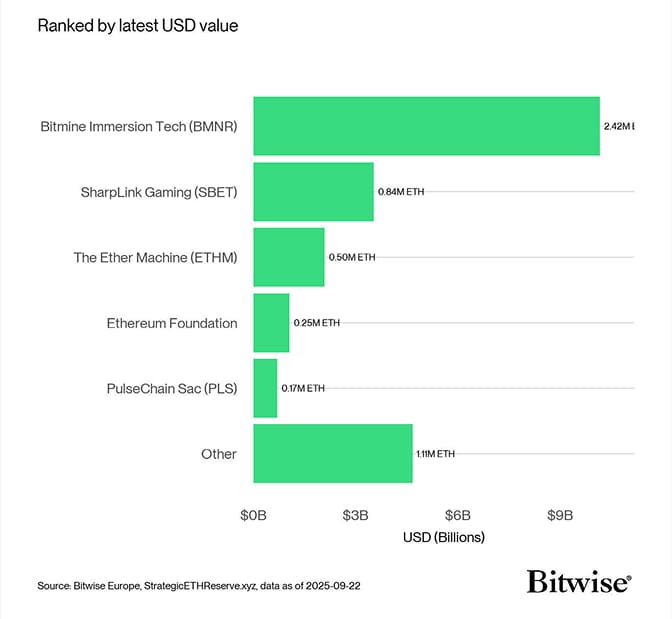 Source: Bitwise Europe, StrategicETHReserve.xyz, data as of 2025-09-22
Source: Bitwise Europe, StrategicETHReserve.xyz, data as of 2025-09-22
Market Structure & Concentration
Sharks Dominate the Landscape
The distribution of DATs skews heavily toward “sharks” (1k–100k ETH) and “fish” (101–1k ETH), with relatively few “whales” and only one “mega whale” (BitMine). This depicts a future reality of a “winner takes most” outcome because raising capital at scale is easier for large, credible entities, while mid-sized DATs struggle to attract equivalent enthusiasm. We expect consolidation over time, with a small number of dominant players commanding most flows - much like what we've seen in BTC DATs.
ETH Treasury Size Distribution
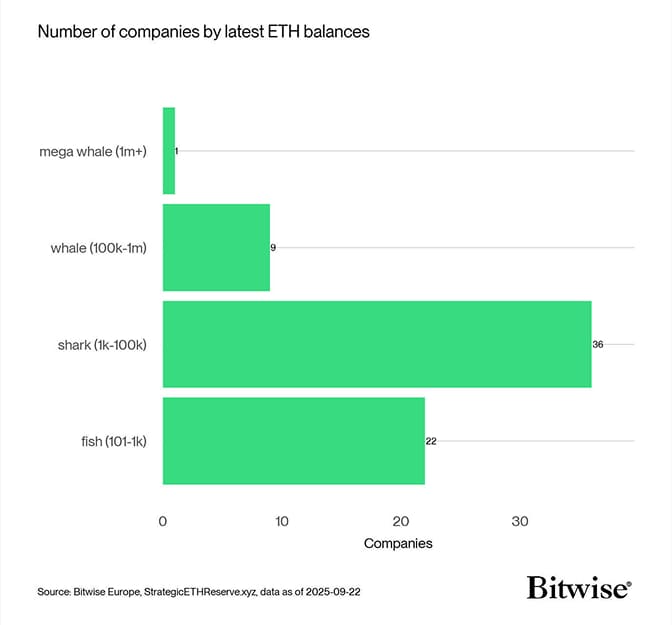 Source: Bitwise Europe, StrategicETHReserve.xyz, data as of 2025-09-22
Source: Bitwise Europe, StrategicETHReserve.xyz, data as of 2025-09-22
Summary: ETH Treasuries Enter the Mainstream
Ethereum's evolution as a treasury asset is accelerating. DATs have transformed from a Bitcoin-centric play into a structural feature of the digital asset economy, now pulling ETH into balance sheets at scale. DATs are creating persistent demand that exceeds net new supply, reinforcing ETH's scarcity while layering on real yield from transaction fees and MEV.
Adoption is broadening. 68 entities now hold ETH reserves and the top five treasuries showcase diverse strategies ranging from corporate accumulation and staking, to foundations divesting for ecosystem growth. This diversification highlights Ethereum's dual role: both an economic reserve asset and a productive, yield-bearing instrument.
Yet the landscape is likely to consolidate in the future. Larger “mega whale” and “whale” DATs dominate flows, pointing toward a winner-takes-most future where credibility, scale, and governance influence compound over time. As this dynamic unfolds, Ethereum is carving out a unique position: not just a hedge or speculative play, but a programmable treasury asset that links corporate finance with on-chain economics.
In short: ETH treasuries are no longer a side story. They are becoming a structural pillar in crypto's capital markets.
Important information:
This article does not constitute investment advice, nor does it constitute an offer or solicitation to buy financial products. This article is for general informational purposes only, and there is no explicit or implicit assurance or guarantee regarding the fairness, accuracy, completeness, or correctness of this article or the opinions contained therein. It is advised not to rely on the fairness, accuracy, completeness, or correctness of this article or the opinions contained therein. Please note that this article is neither investment advice nor an offer or solicitation to acquire financial products or cryptocurrencies.
Before investing in crypto ETPs, potentional investors should consider the following:
Potential investors should seek independent advice and consider relevant information contained in the base prospectus and the final terms for the ETPs, especially the risk factors mentioned therein. The invested capital is at risk, and losses up to the amount invested are possible. The product is subject to inherent counterparty risk with respect to the issuer of the ETPs and may incur losses up to a total loss if the issuer fails to fulfill its contractual obligations. The legal structure of ETPs is equivalent to that of a debt security. ETPs are treated like other securities.

